A half-mile section of North Lombard (Highway 30) in the University Park and Portsmouth neighborhoods is getting bike lanes.
“Getting across Lombard has always been tough. The bike access and traffic island will really help.”
— Mary-Margaret Wheeler, resident of Portsmouth Neighborhood.
That might not seem like big news until you consider this: This will be the first section of Lombard west of Martin Luther King Jr. Blvd to get bike lanes and this a major freight route controlled by the Oregon Department of Transporation — an agency known for, shall we say, conservative roadway management.
ODOT Region 1 Transit and Active Transportation Liaison Jessica Horning says this restriping project in particular is happening because “All of the different pieces just fell together.” Horning, who presented the idea at a meeting of the Portsmouth Neighborhood Association Tuesday night, told us in an interview yesterday that the bike lanes and redesign of this stretch of Lombard came about due to “Agencies and developers working together well in an a way that doesn’t typically happen.”
The catalyst was the development of a New Seasons Market that is set to open early next year at Lombard and Westanna Avenue.
The project will restripe Lombard between N Ida and Wall. The New Seasons site is on the western edge of the project (between Westanna and Wall). Horning says that the section of Lombard to the east of the new store has been on their radar as a safety concern for years.
According to ODOT crash data several sections of Lombard west of Martin Luther King Jr. Blvd are among the most dangerous roadways in Oregon. The section between New Seasons and Ida specifically ranks among ODOT’s top 10% sites in the agency’s Safety Priority Index System. “The area to the west of the New Seasons site is pretty high on that list,” Horning said.
But it wasn’t high enough up on the list to actually get any funding until New Seasons came along and “opened up a door” for the project to happen. The new store’s driveway triggered the need for a left-turn pocket, which opened up the possibility for the bike lanes.
“[The need for the left-turn pocket] meant we could try and find some funding and address a known safety problem that gets us some better connectivity between New Seasons, the Peninsula Crossing Trail, and existing bike lanes and neighborhood greenways,” Horning said. “We know kind of demand and behavior we’re going to have at this store and we’re planning ahead for it.”
The case for bike lanes here was also strengthened by the 2004 St. Johns/Lombard Plan which stated, “Between Van Houton [one block west of this project’s boundary] and Ida Streets there is sufficient right-of-way currently to provide bike lanes on Lombard without impacts to on-street parking or the number of travel lanes.”
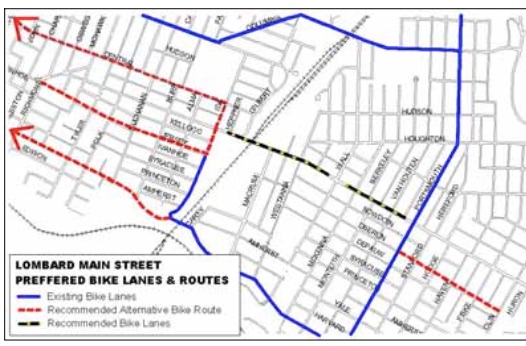
With strong policy footing, Horning went out and got a $10,000 “Quick Fix” grant from ODOT’s bicycle and pedestrian program and added it to what New Seasons is required to pay as part of their development.
Advertisement
The new bike lanes will be five feet wide in most places, growing to seven feet wherever there’s space. That’s far from ideal in an era when we know protected bike lanes are what really encourage cycling, but Horning says Lombard’s freight designation meant they had to maintain 12-foot standard lanes. Anything narrower would require sign-off from the state freight committee in Salem; a step Horning said could have killed the entire project.
(In a May 2013 story about bike lanes on Lombard ODOT’s Freight Mobility and Construction Project Liaison Tony Coleman told us, “If they can figure out a 12-foot lane adjacent to the bike lane, we could work with that.”)
Unfortunately the project will leave a bike access gap where Lombard crosses a railbed on a bridge owned by Union Pacific. Horning said because the road narrows on the bridge there’s “not enough width to feel safe striping a bike lane.” People riding bikes will either have to take the lane or use the bridge sidewalks.
In addition to the new bike lanes and left-turn lanes, this project will also come with median islands in front of New Seasons at Fortune Avenue to make it easier to walk across Lombard. ODOT plans to commission a traffic study in six months to determine if a flashing beacon is needed to boost the crossing at Fortune. If it is, there’s already funding set aside to install it.
Mary-Margaret Wheeler with the Portsmouth Neighborhood Association said the neighborhood’s response to the project has been “really positive.” Wheeler has lived in the area for 14 years and recalls walking this stretch of Lombard as part of the 2004 plan. “I’m really excited about the work that will be making Lombard into less of a barrier,” she shared with us yesterday, “Getting across Lombard has always been tough. The bike access and traffic island will really help.”
Wheeler did add however that there are some concerns that New Seasons customers will park on nearby streets and a few business owners along the project boundary might not be happy to lose their on-street parking. The new bike lanes will be installed in what’s currently a parking lane; but ODOT says it was very rarely used.
Changing Lombard from the loud, dirty and dangerous highway it currently is into a more human-scale neighborhood street like it should be has stoked dreams and hopes of planners and residents for many years. Now there seems to be real momentum. While the ideal situation would be for the City of Portland to wrest control of it away from ODOT (a bill this legislative session that would have made that possible didn’t pass), this and a few other projects in the pipeline could have significant impacts.
The Portland Development Commission has embarked on a project to improve Lombard (they had an open house on it last night). Their project will focus more toward the east in the same area that Portland State University students researched in the Lombard Re-Imagined effort.
And ODOT is already working on another safety project on Lombard currently winding its way through their 2019-2021 Statewide Transportation Improvement Program. We’ll have more on that soon.
For now, we’ll await these new bike lanes and see how they work. They should be on the ground any day now.
— Jonathan Maus, (503) 706-8804 – jonathan@bikeportland.org



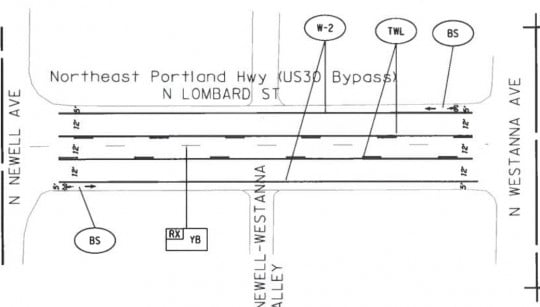
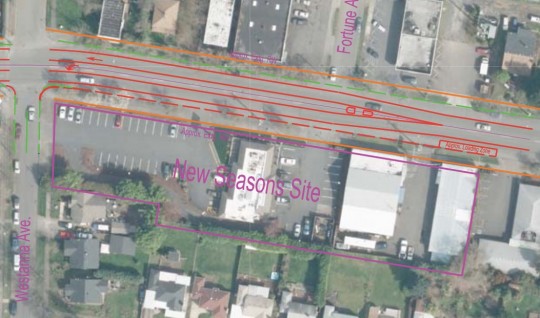
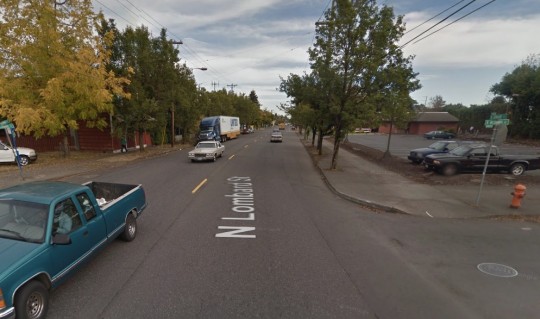
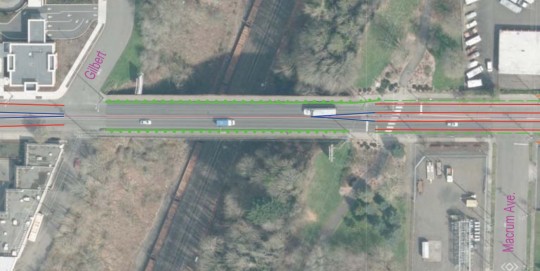

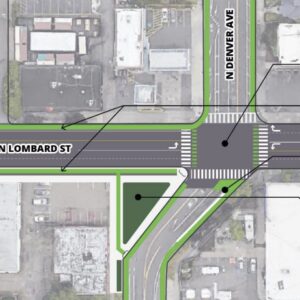
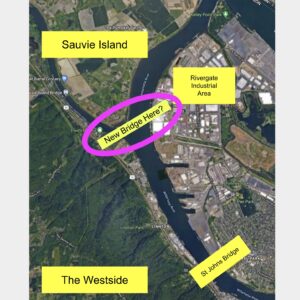

Thanks for reading.
BikePortland has served this community with independent community journalism since 2005. We rely on subscriptions from readers like you to survive. Your financial support is vital in keeping this valuable resource alive and well.
Please subscribe today to strengthen and expand our work.
I’m shocked that ODOT is planning to add bike lanes, cautiously optimistic even that this could be ODOT turning over a new leaf?
Then again, it looks like there are some sections of bike lane missing in that graphic (it’s very blurry), are these going to just be bike lanes to nowhere or will they connect meaningfully?
They are really just adding narrow shoulders. Not bike lanes.
The 12 foot lanes are not needed more than 10% of the time for trucks. Why not stripe the outside lanes 10 feet wide with a 2 foot buffer next to the 5 foot minimalist bike lanes? The hole in the air will be the same and 90% of the traffic will be a foot or two farther from the bike lane.
The roadway appears to have a 35-mph speed limit. Cyclists struck at 35 mph have a 90% risk of fatality per OECD.
http://www.internationaltransportforum.org/jtrc/safety/targets/targets.html
Trucks don’t need 12 foot lanes any more than cars do. Max width on any vehicle not displaying oversize load is 8.5 feet.
The problem is our tolerance of oversize loads and being allowed to run them during the day without a pilot car escort.
Did you know N Lombard IS the oversize truck route? The standard sized loads are mostly directed to N Columbia Blvd, but overpass limitations at George Middle School and the UP rail overpass near Denver preclude it for overheight loads. These mostly go via Lombard, but usually in the evening. 12 foot lanes are probably minimal in this regard.
I do also have to note ODOTs working with City of Portland and the SJ Neighborhood Assoc to add curb tip-outs and improved lighting between N Burr and N Mohawk along Lombard. Business development in that area contributed to mid block crossings in a very busy, congested area. While not complete yet, it is IMO, a big improvement, both safety wise and in how ODOT relates to affected/afflicted neighbors.
But I DO hope someday, somehow, N Columbia Blvd gets the make over it needs to become the FULL truck route.
They have an entire center lane to use as well. If they indeed need that width.
Then there is the National Highway System designation which requires minimum 11 ft lanes.
Mark,
Did you forget mirrors?
You only need space on the ground for mirrors when passing oversized trucks or tallbikes. Should we stripe some “truck/bus mirror only” lanes? Isn’t that the point of the buffer stripe? A bus can get between two bollards 9ft apart, albeit maybe not at 10.5mph over the speed limit.
Thank you for pointing out that overwidth is rarely enforced as it should be enforced. If overwidth was truly enforced, manufactures would simply deploy cameras in the needed places. Instead, they attach massive mirrors. I have had a truck mirror come within a few inches of my head. Not fun.
I work in the trucking business and am appalled at what we let trucking companies and drivers get away with. If you or I are even touched by a truck, chances of us living are slim to none.
Actually fed law requires mirrors. It needs to be changed to allow cameras in place of.
yes
That’s actually a really good idea. I somehow doubt ODOT would go for it, though.
There are enough issues in this post to put it in the “not even wrong” category.
This is a smaller sliver of Lombard than the headline would have you believe. Overlook isn’t even adjacent to Portsmouth. MLK isn’t in the 5Q at all..
Thanks Champs. I meant University Park N’hood, not Overlook.
This is pretty cool, be nicer if it was a longer stretch but there is a small path you can take near the bridge to get to Willamette for the longer bike path into/from St Johns.
If we’re going to consider Willamette a bike path, let’s have the speed limits lowered to 25. 35 is too much for a two lane, bike and parking stripped, residential road. Much of Lombard is or will be 25.
Are they really considering extending the 25 mph further down Lombard? That would be great if so.
Not all the way. While doubtful, I still wouldn’t be surprised if we eventually see 25 mph all the way through to Interstate depending on new business and residential development.
By the end of 2016, I believe all of St. Johns, not including Rivergate (non-residential) and Columbia Blvd, will be 25 mph. This includes St. Louis/Fess and Lombard through to at least the cut.
The ‘small path’ is the peninsula crossing MUP. If you go north on the MUP, or Westanna, you can connect to the N Houghton/Terry greenway that goes all the way to Interstate Ave.
Also,
West of the RR cut, north of Lombard is the N Central Greenway that goes all the way to Pier Park.
Good news. It’d be nice if they could also stripe a pedestrian crossing there at Westanna. That, in addition to the island, would really make crossing Lombard at this location better.
It’s great ODOT is thinking about bicycle transportation, and it’s a great improvement to have any accommodations for bicycles on Lombard. I hope ODOT considers the importance of integrating all modes of transportation on all the facilities it manages.
With that said, there are a number of disappointing aspects of this project as it is currently envisioned. Some of these fall on ODOT for design (and I’ll grant that what is presented here is not the full design so I may well be missing something), but some of them just fall on our general system of planning and politics:
1. Design. Unprotected bike lanes adjacent to 12-foot (i.e. high speed) traffic lanes. Bike lanes to drop on bridge, how will riders be informed of this, and what accommodations will be made to the roadway to make it clear to fast cars and heavy trucks that they need to let bikes in? And don’t tell me those tiny “Bikes in Roadway” signs do anything.
2. Planning. This is just a few blocks. Perhaps a few blocks in a critical stretch, but why isn’t this part of a planned route from MLK to Saint John’s?
3. Timing and Politics. Why do we need a specific development opportunity like New Seasons for everything to magically fall into place funding-wise? It’s basically sending the message to everyone that until your neighborhood gentrifies, don’t expect to see new infrastructure, no matter how cheap ($10,000! That’s nothing in the world of public investment). And when you see new infrastructure, get ready for your rent to increase, if it hasn’t already.
Bingo. This plays perfectly into the “New Seasons -> bikes -> gentrification” cliche.
Apparently, I need to go talk to Wendy Collie if I want bike lanes on NE Halsey St.
One day, I believe our government will actually care about our safety. Until then, at least we have grocery stores.
An important aspect of this change will be the discouragement of trucks from using Lombard. Hopefully they will parallel this with enhancements to get them to Columbia more cleanly.
Also, the area often becomes a threw way for Washington residents going to jobs in Hillsborough. Hopefully, this will get them out of cutting through the neighborhoods and also onto Columbia.
Again with the 12 foot lanes.
Nothing needs 12 foot lanes that doesn’t have an oversize permit. Got that?
Nothing.
The max width is 102 inches.
Bus drivers whine if the lanes are less than 11 feet. Any bus driver worth their salt can put a bus inside 9 feet all day long. They do it on side streets, why do they need 11-12 feet for a 8.5 foot bus?
So..instead bikers get no buffering on this road (NOT A HIGHWAY) so drivers can text and weave in their lane.
I am sooooo tired of the mantro from engineers… “Lanes must be 12 feet!”.
Wider lanes make people go faster like big shopping cars make people buy more.
Long ago, I worked for a trucking firm that hauled tomatoes. Most of our drivers were college students whom we trained in the Spring to drive in the Summer. Some of our fields were on the other side of an eighteen foot wide bridge. Even these newbie truck drivers could go past each other on that bridge at 60 mph with double trailers.
If brand spanking new truck drivers can handle nine-foot lanes in the middle of the night while working sixteen hour shifts, anyone should be able to stay within a ten foot lane. I fully agree with everything you wrote.
Outstanding news, ODOT just installed some pedestrian crossing improvements further west in st. johns
I saw “Lombard” and got excited…
then I saw “half mile”‘ and was less exciting…
then I saw the location and was completely disappointed…
this is probably the nicest stretch of Lombard to bike on along the business district…
why does ODOT even control this road? why do we still have this marked as an archaic 30B business/bypass highway? they really need to develop 120 to the north and stop using this city street as a freight corridor…
https://youtu.be/HMxJtMoTnx8?t=13s
A street as busy as Lombard should get protected bike lanes. I’m skeptical that people will want to ride alongside trucks only separated by paint.
Good first start, but we should do better. With the wide car lanes, and disappearing bike lanes over the bridges; this is more or less just a copy of Barbur, and we all know how dangerous that street is.
My impression from the story is, the plan is to have bike routes (greenways?) on residential side streets close to and paralleling Lombard. This stretch of Lombard doesn’t have such side streets that go through. So the bike lanes would allow cyclists to use Lombard for that stretch, then the cyclists would return to the bike route/side street.
I’m doubtful that a standard bike lane with no buffer will make this a particularly nice place to ride. It will be better than it is now. Protected bike lanes may be difficult due to all the driveways on Lombard.
Our neighborhood greenway system is great for commuting and getting across town. The problem with it, though, is it neccesarily forces people riding bikes off the main streets where the majority the businesses are. Our bicycle infrastructure breaks down when people need access to stores, restaurants, etc.
This is why I support creating safe ways to cycle on arterials. Not everyone is just biking to work. For a city to function well for cycling, there needs to be access to everything else by bike as well.
As far as addressing the driveways, the best practice would be a raised crosswalk. Essentially, keep the sidewalk and cycle track at the same level and make people drive up onto the curb to access the driveway. Use a “mountable curb” like on the Cully cycle track. Admittedy, this adds cost to what I’m assuming is a very low budget project.
That’s pretty much the environment I learned to ride in back in the late 70’s and early 80’s (though with 45-55 speed limits with or without shoulders – there were no bike lanes then).
Professional drivers in tractor trailers are some of the best drivers in the world. Yes they’re loud, and big. But in my experiences and statistically, you’re more likely to have an incident with a Prisis, Bug. or Yukon before you’d have issues with a big rig. In 2013 of the 882 traffic related bicycle fatalities only 31 bicycle fatalities with heavy transport or buses nationwide. How many were big rigs and how many were buses – don’t know, they’re combined in the CDC cataogicial system
Compare that to the 21 fatalities that year where cyclists died in collisions with “fixed or stationary objects” – which also account for more than 1/3 of bicycle injuries. Those trucks are likely as “safe” or “safer” than those bollards you’re asking for.
Most people don’t know this, but to get a CDL is pretty rigorous now, not just the driving tests, but physical exams and other hoops to jump through too. Too bad a regular license is so easy to get.
Agreed on that front. However, riding next to a tractor trailer feels less safe. If it feels less safe, then less people will ride. The less people who ride, the less safe riding a bike is due to lack of safety in numbers. We absolutely should use data to inform decisions. But perception of safety matters as well.
I wonder if the people who are scared to ride next to a tractor-trailer would be as likely to be killed by impact with a stationary object? Seems like they wouldn’t generally impact poles at that speed. We should breakdown those figures between upright transportation riders vs recreational road racers.
YES! I live on Wabash so this is pretty much amazing for me. I’d love to see it go further and it’d be nice if it was like 2017 but I am not complaining. So happy to hear this!
Sorry I was reading two different sources. I was referring to the stretch from Woolsey to Peninsula (The west edge of Columbia park to the Green Zebra). Which I have heard rumor was announced at the Lombard Open house last night for groundbreaking in 2019. The article mentions more to come on that soon but from the sound of it it will be similar to this stretch, though parking in lieu of bike paths is still on the table.
Yup, it’s a short section. Nope, they are not protected. Both of those things are disappointing.
But we’ve gone from thinking that bike lanes on any stretch of Lombard would be impossible forever, to saying “We want to try and get bike lanes on this street,” to “Hey, these are here but why aren’t they better and everywhere?”
We’re having a very different conversation now and that IS progress, especially on an ODOT stroad. It’s proof that it is possible to make changes here. This isn’t the anticlimactic end of the story, it’s the beginning of bigger and better changes – as long as people keep pushing.
What you’ll likely get on the bridge over the UPRR/Amtrak line are ramps leading onto the sidewalk, with signs reading “Bikes Must Use Sidewalk on Bridge,” placed over the sidewalk with an arrow pointing down at the ramp.
I hate to be utterly pedantic, but the railroad line going through the cut is owned by BNSF, not Union Pacific. Same goes for the bridges crossing the cut at Willamette, Lombard, and Fessenden.
It’s a weird situation where the City more than a hundred years ago gave permission to the railroad to dig the cut and wipe out the street grid, but only if the railroad promised to build those three bridges and continue to own and maintain them. It was a bad idea in retrospect, because now they own bridges they don’t care about and barely maintain. They are all in terrible shape, some of the most structurally-deficient bridges in the city.
Most of the railroads were here before Portland became a city.
“Unfortunately the project will leave a bike access gap where Lombard crosses a railbed on a bridge owned by Union Pacific.”
I’m pretty sure that bridge is owned by BNSF, since those are BNSF tracks in “The Cut”.
This is great news, and hopefully just the first step. The highway should be rerouted to Columbia. Dig a tunnel from the bridge through St John’s. Lift some overpasses on Columbia for the trucks. Then put a streetcar and bike lanes on Lombard. So simple.
Yes, it is simpleish. However, knowing ODOT..they would allocate a billion dollars to the project weighing it down like water on the Titanic.
The railroad bridge makes for a difficult bike crossing. Needed is a new pedestrian and bike bridge to connect the peninsula with the rest of the city.
The bridge, curb to curb, is about 36 feet. that would be enough for PBOT to stripe two 10 ft lanes and two 6-ft bike lanes with 2 foot buffers.
BTW, the concept to extend N Central across the cut has been floated inside PBOT. $500K-$1M is the very preliminary estimate.
After thinking about this…I am still appalled at what ODOT thinks this as an improvement. An improvement would be to extend the current sidewalk 6 feet in either direction, stripe it for bikes and then call that an improvement. Instead, cyclists are expendable. Not even deserving of a raised or truly separated system.
Given the stated width of the roadway, something has to be substandard width (unless we’re going to actually start rebuilding the roads to twenty-first century standards). It strikes me as insane to make the bike lanes substandard (state standard six foot minimum) rather than narrow the two-way left turn lane to ten feet. The freight trucks aren’t going to be turning, and even if they do they can fit in a ten foot lane. Why oh why does that lane need to be twelve feet?
there needs to be a comprehensive vision for Lombard beyond these brief interludes of lane changes and bike lanes- from St Johns/west to Parkrose/east.